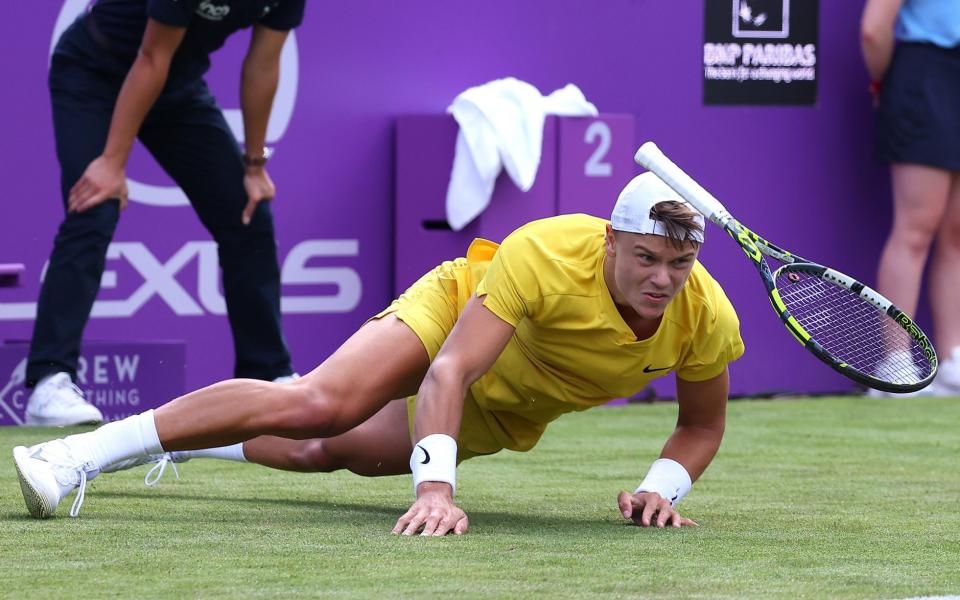Queen’s engulfed in fresh slippery court row as players rage at ‘terrible’ surfaces

The “slippery” grass courts at Queen’s have come under fire after a series of heavy falls on the opening day of the cinch Championships, including one that left former world No 10 Frances Tiafoe hobbling out of the tournament.
Holger Rune, the seventh seed from Denmark, was another man who struggled with his footing. After several mis-steps in his match against the more experienced grass-courter Jordan Thompson, Rune seemed to lose enthusiasm for the contest and slid to a three-set defeat.
“This court is so slippy,” Rune complained to umpire James Keothavong during the deciding set. “Terrible court, what is this? I can’t stand on the court. It’s too wet. Call the supervisor. I fell three times. It’s too wet. You think I’m falling on purpose?”
Posting on social media, the former Wimbledon semi-finalist John Isner gave his own opinion. “Queen’s is undoubtedly one of the best events of year,” said Isner, who retired last year. “But the courts are diabolically slippery, especially on Monday and Tuesday. Just ask DelPo. Sucks for Frances, hope he can recover for SW19.”
Isner was referring to the 2019 match at Queen’s where Juan Martin Del Potro slipped and fell, reinjuring his knee only a matter of months after he had recovered from a long-term injury.
In Tiafoe’s case, he fell heavily on his hip in the early stages of the third set against Australia’s Rinky Hijikata. After trying unsuccessfully to hit a couple of serves, he retired from the match.
Get well soon, @FTiafoe 🙌
After a nasty fall, Tiafoe is forced to retire sending Hijikata through to R16 at Queens#CinchChampionships pic.twitter.com/VrdASi5V1j— Tennis TV (@TennisTV) June 17, 2024
Later on, both Alejandro Davidovich Fokina and Alejandro Tabilo experienced multiple issues with their footing in Monday’s final match on Centre Court. Play was eventually suspended soon after 8pm because of the slipperiness of the conditions, even though there would have been enough light to continue a match which saw Tabilo leading 2-0 in the deciding set.
Rune expanded on the issue in the interview room after his 4-6, 7-6, 6-3 loss to Thompson. “It was quite slippery, to be honest,” he said. “I slipped maybe three times, one time quite important. It helps for the movement when it [the court] is played [on] a little bit, but then when it’s played a lot on it gets slippery again. Yeah, then it gets kind of dirt behind the baseline.
“We just have to adjust and I didn’t do it good enough today. I can blame the court, but that’s not going to help.”
An LTA spokesman told Telegraph Sport: “Grass courts are a living surface and will always react to weather conditions in the lead up to the event, usually having a tendency to play a little slippier at the start of the tournament.
“As everyone knows we have experienced exceptionally cooler and wetter weather the last couple of months in the UK and the outstanding grounds team at the Queen’s Club have done their very best to adapt to this, applying the same rigorous preparation as they always do.”
Grass-court movement is a specialist skill. For players who have not spent much time on the surface, it can be difficult to pick up, especially given the vast difference between clay – where sliding is the best option – and the catlike baby-steps required by old-fashioned “lawn tennis”.
Germany’s former world No 9 Andrea Petkovic, who is now a pundit and commentator, recently explained on her Substack blog that she always hated this part of this season.
“BROCCOLI SEASON is upon us, friends,” Petkovic wrote. “I got a big flash of PTSD when I turned on my TV to see grass courts lurking, their creepy non-sounds when the tennis balls hit the court and those weird tiny little steps players have to take not to face-PLANT at all times. Ugh. Get off my lawn! Literally.”
While Queen’s Club is generally agreed to have some of the best grass courts in the world, there is a lush green texture to the surface in the early stages that tends to result in more falls.
Next year, it will be the women who get first go on these courts, as the WTA are staging a 500-point tournament at Queen’s before the men. Representatives from the ATP – who run the men’s tour – are understood to have expressed concern that the courts might look scruffy and play unpredictably by the time their own event starts. But as the ATP’s tournament director Jamie Murray recently explained, there could be benefits to the new schedule as well as drawbacks.
“The Centre Court won’t look absolutely pristine on Monday at 12 o’clock [for the men], which is what everyone’s used to experiencing,” said Murray. “But they’ll still play amazingly well.” Asked if the courts might be less slippery, he replied “That is true, yeah. It’ll have a week’s play on it. So I think in that situation it is probably a positive for the men’s event.”

 Yahoo Sport
Yahoo Sport 






































